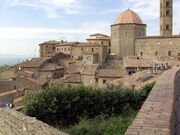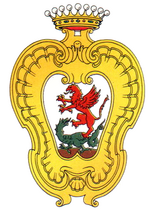(Inerference with bullet list) Tag: rte-source |
|||
| (43 intermediate revisions by 23 users not shown) | |||
| Line 1: | Line 1: | ||
| + | [[File:Volterra_.jpg|left|thumb|Volterra]] |
||
| − | '''Volterra |
+ | '''Volterra''' is a town in Tuscany, Italy. In the [[Twilight series|''Twilight'' series]], it is the ancient Italian city where the [[Volturi]] reside. It is very beautiful, situated on a hill and built from sienna (or cinnamon brown) stone, and is known as the safest place in the world from vampire attack. The Volturi do not permit any sort of hunting there as they do not like anything that could expose them. On their way to Volterra, [[Alice]] explains to [[Bella]] that the Volturi themselves bring in their food from outside, sometimes quite far away. |
==In the ''Twilight'' series== |
==In the ''Twilight'' series== |
||
| Line 6: | Line 7: | ||
Originally, [[Stephenie Meyer]] planned to have the Volturi live in a fictional city called "Volturin". She had decided that the city would be in Tuscany, and that its main square would contain a clock tower. After examining a map of the region, she discovered Volterra close to where she was going to set Volturin, and learned that it also had a clock tower like the one she had described for her city. Thus, she decided to use the real city of Volterra in the series. <ref>[http://www.twilightlexicon.com/2009/11/17/stephenie-meyer-answers-your-questions/ Stephenie Meyer answers your questions | Twilight Lexicon]</ref> |
Originally, [[Stephenie Meyer]] planned to have the Volturi live in a fictional city called "Volturin". She had decided that the city would be in Tuscany, and that its main square would contain a clock tower. After examining a map of the region, she discovered Volterra close to where she was going to set Volturin, and learned that it also had a clock tower like the one she had described for her city. Thus, she decided to use the real city of Volterra in the series. <ref>[http://www.twilightlexicon.com/2009/11/17/stephenie-meyer-answers-your-questions/ Stephenie Meyer answers your questions | Twilight Lexicon]</ref> |
||
| − | For the film ''[[New Moon (film)|New Moon]]'', the Volterra scenes were actually filmed in [[Montepulciano, Italy]]. The biggest problem the people of Volterra had with Stephenie's book was the fact that Bella ran through a fountain to get to Edward when there |
+ | For the film ''[[New Moon (film)|New Moon]]'', the Volterra scenes were actually filmed in [[Montepulciano, Italy]]. The biggest problem the people of Volterra had with Stephenie's book was the fact that Bella ran through a fountain to get to Edward when there isn't one in the actual main square of city; the producers had to build one in the center of the filming location. |
==History== |
==History== |
||
| + | [[File:Volterra-Stemma.png|thumb|150px|Coat of Arms]] |
||
Volterra was a Neolithic settlement and an important Etruscan center with an original civilization; it became a municipium in the Roman Age. The city was a bishop's residence in the fifth century and its episcopal power was affirmed during the twelfth century. With the decline of the episcopate, Volterra became a place of interest of the Florentines, whose forces conquered Volterra. Florentine rule was not always popular, and opposition occasionally broke into rebellion. These rebellions were defeated by Florence. |
Volterra was a Neolithic settlement and an important Etruscan center with an original civilization; it became a municipium in the Roman Age. The city was a bishop's residence in the fifth century and its episcopal power was affirmed during the twelfth century. With the decline of the episcopate, Volterra became a place of interest of the Florentines, whose forces conquered Volterra. Florentine rule was not always popular, and opposition occasionally broke into rebellion. These rebellions were defeated by Florence. |
||
When the Florentine Republic fell in 1530, Volterra came under the control of the Medici family and later followed the history of the Grand Duchy of Tuscany. |
When the Florentine Republic fell in 1530, Volterra came under the control of the Medici family and later followed the history of the Grand Duchy of Tuscany. |
||
| + | |||
| − | ==Main |
+ | ==Main sights== |
*Roman Theatre (1st century BC), excavated in the 1950s. |
*Roman Theatre (1st century BC), excavated in the 1950s. |
||
*''Piazza dei Priori'' |
*''Piazza dei Priori'' |
||
| Line 22: | Line 25: | ||
*The Etruscan walls, including the well-preserved ''Porta dell'Arco'' (3rd-2nd centuries BC) and ''Porta Diana'' gates. Outside the city, in direction of Lajatico, is the Medici Villa di Spedaletto. Also in the neighborhood, in the Valle Bona area, are excavations of Etruscan tombs. |
*The Etruscan walls, including the well-preserved ''Porta dell'Arco'' (3rd-2nd centuries BC) and ''Porta Diana'' gates. Outside the city, in direction of Lajatico, is the Medici Villa di Spedaletto. Also in the neighborhood, in the Valle Bona area, are excavations of Etruscan tombs. |
||
| − | == |
+ | == References == |
| − | <gallery widths="300px" heights="200px" perrow="2"> |
||
| − | Image:Volterra.jpg|A picture of Volterra, Italy. |
||
| − | Image:Volterra2.jpg|A Roman theatre in Volterra. |
||
| − | </gallery> |
||
| − | |||
| − | == References == |
||
{{reflist}} |
{{reflist}} |
||
| + | ==External links== |
||
| ⚫ | |||
| + | *[[wikipedia:Volterra|Volterra]] on Wikipedia |
||
| + | ==See also== |
||
| − | {{Stub}} |
||
| + | *[[Gallery:Locations#Volterra, Italy]] |
||
| + | |||
| ⚫ | |||
{{Wikipedia}} |
{{Wikipedia}} |
||
| − | [[Category: |
+ | [[Category:Locations]] |
[[Category:Real world]] |
[[Category:Real world]] |
||
Revision as of 22:42, 27 February 2015

Volterra
Volterra is a town in Tuscany, Italy. In the Twilight series, it is the ancient Italian city where the Volturi reside. It is very beautiful, situated on a hill and built from sienna (or cinnamon brown) stone, and is known as the safest place in the world from vampire attack. The Volturi do not permit any sort of hunting there as they do not like anything that could expose them. On their way to Volterra, Alice explains to Bella that the Volturi themselves bring in their food from outside, sometimes quite far away.
In the Twilight series
In the Twilight series, the Volturi live in Volterra and rarely leave the city. In New Moon, the city is seen celebrating Saint Marcus Day (the eponymous Marcus of the Volturi) as the day when St. Marcus supposedly drove all vampires away from the city.
Originally, Stephenie Meyer planned to have the Volturi live in a fictional city called "Volturin". She had decided that the city would be in Tuscany, and that its main square would contain a clock tower. After examining a map of the region, she discovered Volterra close to where she was going to set Volturin, and learned that it also had a clock tower like the one she had described for her city. Thus, she decided to use the real city of Volterra in the series. [1]
For the film New Moon, the Volterra scenes were actually filmed in Montepulciano, Italy. The biggest problem the people of Volterra had with Stephenie's book was the fact that Bella ran through a fountain to get to Edward when there isn't one in the actual main square of city; the producers had to build one in the center of the filming location.
History

Coat of Arms
Volterra was a Neolithic settlement and an important Etruscan center with an original civilization; it became a municipium in the Roman Age. The city was a bishop's residence in the fifth century and its episcopal power was affirmed during the twelfth century. With the decline of the episcopate, Volterra became a place of interest of the Florentines, whose forces conquered Volterra. Florentine rule was not always popular, and opposition occasionally broke into rebellion. These rebellions were defeated by Florence.
When the Florentine Republic fell in 1530, Volterra came under the control of the Medici family and later followed the history of the Grand Duchy of Tuscany.
Main sights
- Roman Theatre (1st century BC), excavated in the 1950s.
- Piazza dei Priori
- Palazzo dei Priori. Begun in 1208 and finished in 1257.
- Pinacoteca (Art Gallery) in Palazzo Minucci-Solaini. The Gallery was founded in 1905 and consists mostly of works by Tuscan artists from 14th to 17th centuries. Includes Deposition by Rosso Fiorentino.
- Cathedral of Santa Maria Assunta. It was enlarged in the 13th century after an earthquake. It houses a ciborium and some angels by Mino da Fiesole, a notable wood Deposition (1228), a masterwork of Romanesque sculpture and the Sacrament Chapel, with paintings by Santi di Tito, Giovanni Balducci and Agostino Veracini. In the center of the vault are fragments of an Eternal Father by Niccolò Circignani. Also noteworthy is the Addolorata Chapel, with a terracotta group attributed to Andrea della Robbia and a fresco of Riding Magi by Benozzo Gozzoli. In the nearby chapel, dedicate to the Very Holy Name of Jesus, is a table with Christ's monogram, allegedly painted by Bernardine of Siena. The rectangular bell tower is from 1493.
- Medicean Fortress (Maschio), now a penitentiary.
- Guarnacci Etruscan Museum, with thousands of funeral urns dating back to the Hellenistic and Archaic periods. Main attractions are the bronze statuette "Shadow of the Night" and the sculpted effigy of an Etruscan couple in terra cotta.
- The Etruscan walls, including the well-preserved Porta dell'Arco (3rd-2nd centuries BC) and Porta Diana gates. Outside the city, in direction of Lajatico, is the Medici Villa di Spedaletto. Also in the neighborhood, in the Valle Bona area, are excavations of Etruscan tombs.
References
External links
- Volterra on Wikipedia
See also
| Locations | |
|---|---|
| Washington cities | Forks • La Push • Port Angeles • Seattle |
| Other cities | Denali, Alaska • Jacksonville, Florida • Biloxi, Mississippi • Philadelphia, Pennsylvania • Phoenix, Arizona • Volterra, Italy |
| Businesses | The Lodge • Mimi's School of Dance • Newton's Olympic Outfitters • Thunderbird and Whale Bookstore |
| Other locations | Character homes • First Beach • Forks High School • Forks Hospital • Isle Esme • La Bella Italia • The Meadow |
| This page uses Creative Commons Licensed content from Wikipedia (view authors). |
